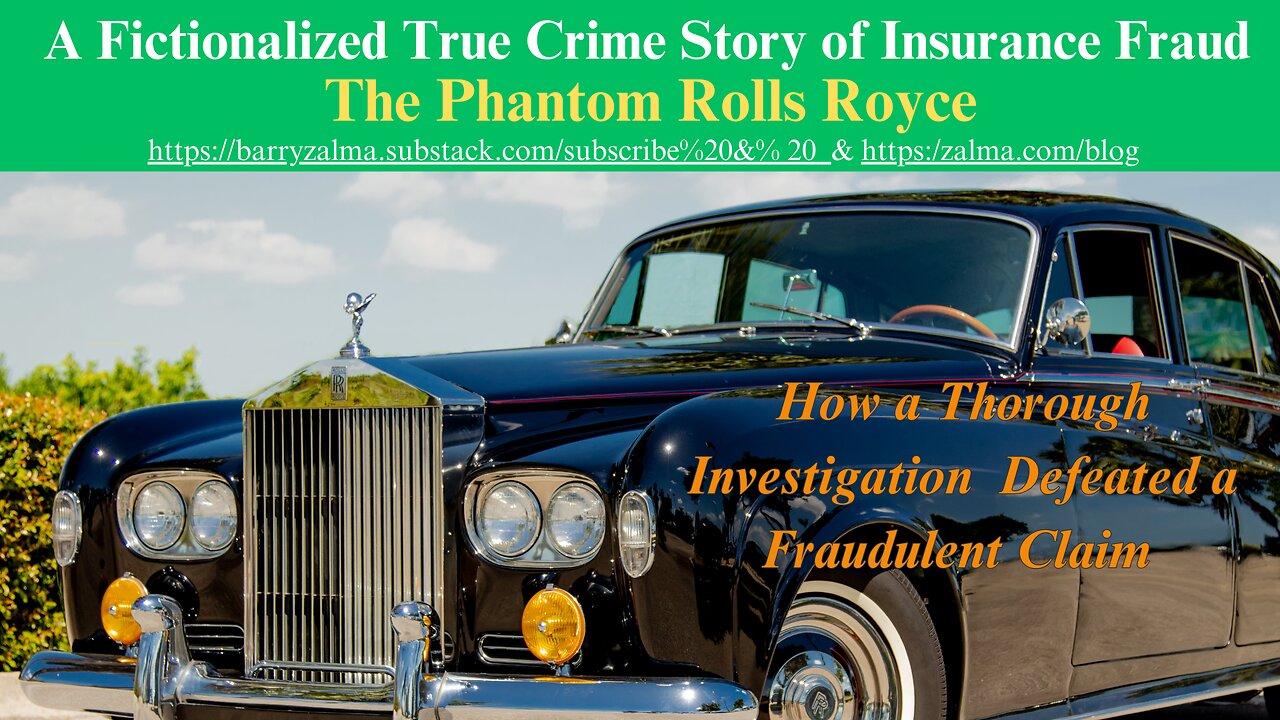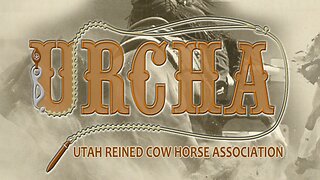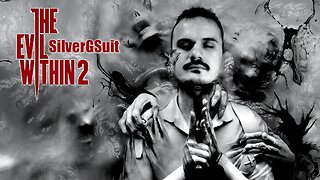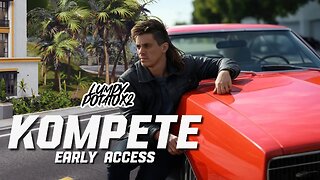Premium Only Content

A Fictionalized True Crime Story of Insurance Fraud
The Phantom Rolls Royce
Post 4832
This is a Fictionalized True Crime Story of Insurance Fraud from an Expert who explains why Insurance Fraud is a “Heads I Win, Tails You Lose” situation for Insurers. The story is designed to help everyone to Understand How Insurance Fraud in America is Costing Everyone who Buys Insurance Thousands of Dollars Every year and Why Insurance Fraud is Safer and More Profitable for the Perpetrators than any Other Crime.
In many states, before a car can be insured, the agent must photograph the car and its vehicle identification number. This regulation is an effective weapon against fraudulent auto theft claims and some states has been removed.
THE INSURED
The insured managed to purchase material damage insurance on a Rolls Royce in a state where the regulation was fully effective even though he never owned a Rolls Royce automobile. His technique was flawless. His planning immaculate. He was only thwarted in his efforts because of the actions of a dedicated and thorough investigator.
To start his plan, the insured went to a Beverly Hills classic automobile dealer and took two Polaroid photographs (slightly out of focus) of a 1946 Rolls Royce. Unlike modern cars, the vehicle identification number was not in the windshield of the Rolls. It was, however, written on the specification sheet provided to him by the dealer.
The insured next began the effort to create an artificial 1946 Rolls Royce. First, he visited the California Department of Motor Vehicles. He obtained from the department forms for the issuance of replacement title and registration documents.
He filled the documents out using a vehicle identification number similar to the one in the showroom, but 2000 digits higher. He also filled out a sworn declaration of lost title and signed it with the name John Jones, vice president, Lincoln Savings & Loan, the lender. The Department of Motor Vehicles processed his application for lost title and registration without inquiry. A new ownership certificate showing ownership in Lincoln Savings & Loan was then issued and delivered to the insured’s post office box.
The insured then filled out a Department of Motor Vehicles bill of sale, reflecting that the Rolls Royce was sold by Lincoln Savings & Loan to his neighbor for a total of $5,500.00. The Department of Motor Vehicles billed the neighbor for license plates and registration based on the value of the sale. The insured captured the mail before it was delivered to the neighbor and paid the bill with a post office issued money order.
The insured then forged the signature of his neighbor on the ownership certificate transferring title to himself. A new bill of sale was again recorded, reflecting a purchase price of $45,600.00 by the insured from his neighbor. He then paid the license fees and requested plates and a certificate claiming the old license plates had been lost or stolen.
At his local public library, the insured read through a classic car magazine and found that 1946 Rolls Royces in fair condition were selling for approximately $100,000. He also learned that the Classic Car Insurance Company was willing to insure classic cars (with limited use) by mail. He photocopied the application for insurance at the library photocopy machine and applied for a $100,000 policy on his 1946 Rolls Royce. The Insured attached to the application one of the Polaroid photographs he had taken at the dealership.
THE INVESTIGATION
Classic Car Insurance Company, taking his application on face value, issued the policy. Since the Insured advised Classic Car Insurance Company that the car was only to be driven 1,000 or less miles a year, the premium on the policy, including third party liability coverage, was less than $1,000. The insured financed the premium with a local insurance financing company and only had to make a $200 down payment. His first payment was due thirty (30) days later.
Two days before the payment was due, the insured telephoned the Los Angeles County Sheriff from a Denny’s restaurant in Lakewood, California and reported his Rolls Royce stolen. He told the police he had taken it to the restaurant for lunch and when he returned it was gone.
The police dutifully took down the report and began looking for the 1946 Phantom Rolls Royce. The insured made a report to Classic Car Insurance Company and immediately, in response to its request, submitted a sworn declaration of auto total theft making claim for $100,000.
Classic Car Insurance Company, as required by California law, maintains a special investigation unit. When the report came in a computer search was performed. The search revealed that other claims payments and a three-year-old theft loss of a classic Mercedes Benz was reported by a person with the same last name as the insured.
The old file was taken out of archives and it was determined that the vehicle was owned by the insured’s mother, but was being driven by him when it was stolen from a restaurant parking lot. The Classic Car Insurance Company had paid the insured’s mother $75,000 for the loss of her Mercedes. The coincidence was too great to ignore.
The investigator began to do the work he was trained to do. He first checked the database maintained by the National Insurance Crime Prevention Bureau (NICB) and learned the following:
The insured has been the reported victim of two automobile accidents and a residential burglary not reported on the application for insurance.
The insured had been convicted, at age 19, of four counts of forgery of checks causing a bank to lose over a million dollars. He had been sentenced to ninety days in jail and five years of probation for this offense.
The Rolls Royce Motor Company publishes a book of all vehicles manufactured by it with their vehicle identification numbers.
The VIN number of the insured’s Rolls Royce was not in the book.
The investigator then obtained from the Department of Motor Vehicles all of the original sales documents and was surprised to learn that the vehicle Classic Car Insurance Company had insured for $100,000 was reported by the insured to have been purchased for $5,600.
Counsel was retained to represent Classic Car Insurance Company and to examine the insured under oath. At examination under oath, the insured proved himself to be a facile liar. His skill at lying under oath was no match for the facts counsel had from the SIU investigator. Counsel lead the insured down a path of lies. The insured claimed to have purchased the vehicle for $100,000 cash which he obtained from his business, an escort service. He explained he kept the cash at home because it was earnings he did not wish recorded in a bank account.
He produced a bill of sale purportedly signed by the neighbor reflecting a $100,000 sale. The insured produced the ownership certificate and the registration establishing the vehicle existed. He claimed to have forgotten to bring with him the keys to the vehicle. Counsel then presented the true documents, item by item.
The insured claimed that the documents recorded at the Department of Motor Vehicles were filed by the seller and he had no knowledge of the changes made by the seller. In fact, he could not understand why the seller had filed such strange documents.
After counsel had established, with certainly in counsel’s mind, that the insured had sworn falsely, the examination under oath was terminated. Counsel met with the attorney for the insured, privately, and explained that the insured’s claim was in great peril.
The attorney for the insured responded: “The bad faith lawsuit I told you to expect will not be filed by me.”
The insured had made one serious error: he hired an honest lawyer. His lawyer and counsel for the Classic Car Insurance Company discussed possible resolution of the matter, including the withdrawal of the claim or a mutual rescission of the policy. Counsel for the insured promised to speak with his client and communicate with the insurer.
The next day, the insured’s lawyer called counsel for the insurer and said:
“I have conferred with my client who recognizes that his title to the Rolls is not clear. He instructed me to advise you that he is withdrawing his claim.”
“I recognize that your client has a duty to report potential fraudulent claims to the State Bureau of Fraudulent Claims. We request that you do no more than you are required by law to do.”
Classic Car Insurance Company saved a $100,000 claim. It spent $30,000 investigating the claim and defeating it. It was lucky. No litigation followed. It reported the loss to the state’s Fraud Bureau who now has the insured’s name on record. There has been no prosecution.
No prosecution is anticipated or expected. The Fraud Bureau is simply inundated with fraudulent insurance claims and must limit its prosecutorial efforts to major crimes that exceed $1,000,000 or rings of insurance fraud perpetrators who file multiple claims.
ZALMA OPINION
Insurance fraud is estimated by the Coalition Against Insurance Fraud to take about $308 Billion from the insurance industry every year. That estimate is a small percentage of real insurance fraud since most fraud succeeds and like this Rolls Royce claim, are never counted as a fraud regardless how much it cost to defeat the fraud.
(c) 2024 Barry Zalma & ClaimSchool, Inc.
Please tell your friends and colleagues about this blog and the videos and let them subscribe to the blog and the videos.
Subscribe to my substack at https://barryzalma.substack.com/subscribe
Go to X @bzalma; Go to Newsbreak.com https://www.newsbreak.com/@c/1653419?s=01; Go to Barry Zalma videos at Rumble.com at https://rumble.com/account/content?type=all; Go to Barry Zalma on YouTube- https://www.youtube.com/channel/UCysiZklEtxZsSF9DfC0Expg.
Go to the Insurance Claims Library – https://lnkd.in/gwEYk
The Phantom Rolls Royce
Post 4832
-
 33:18
33:18
Athlete & Artist Show
13 hours ago $2.81 earnedHockey Is Back In Europe!
32.5K4 -
 5:33:30
5:33:30
Total Horse Channel
6 hours ago2025 URCHA Futurity | Derby & Horse Show | Sunday
38.6K3 -
 LIVE
LIVE
GhillieSuitGaming
3 hours ago $0.47 earnedThe Evil Within 2: Part 4 - Art Destruction!
55 watching -
 LIVE
LIVE
Chi-Town Gamers Livestreams
3 hours ago $0.56 earnedGears 5 Ep. 4 W/ CTG | Into Kait's Mental Issues | GOW: RELOADED LATER & SHENANIGANS 😎
36 watching -
 LIVE
LIVE
Scottish Viking Gaming
6 hours agoSUNDAY FUNDAY :|: Still in the original packaging! Mint!
29 watching -
 2:20:14
2:20:14
LumpyPotatoX2
4 hours agoKOMPETE: Quick Gameplay - #RumbleGaming
13.8K1 -
 2:16:57
2:16:57
XxXAztecwarrior
5 hours agoSearching for more Reds!!
15.8K1 -
 2:44:34
2:44:34
TheItalianCEO
5 hours agoWhat about an Italian for breakfast?
20.5K2 -
 9:06
9:06
nospeedlimitgermany
1 day ago $1.71 earnedMercedes-Benz 500 SE W126 | 231 PS | Top Speed Drive German Autobahn No Speed Limit POV
22.5K5 -
 7:19:06
7:19:06
IamNibz
7 hours ago $1.40 earnedLaw 56- Elden Ring Challenge (PC)
18.4K